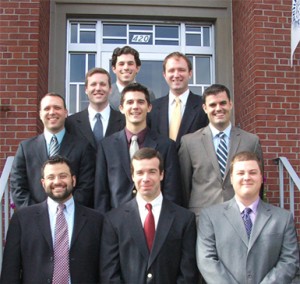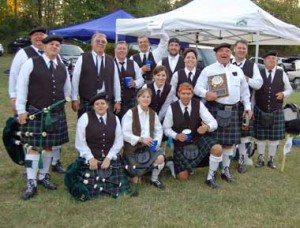There we all were, a long crescent-shaped line of bottle green and saffron, 17 pipers and drummers playing our hearts out onstage in Verizon Hall at Philadelphia’s Kimmel Center, surrounded by roughly 2,500 clapping, cheering, wildly enthusiastic Irish music fans.
And wait, it gets even more awesome. We were accompanying the world’s foremost Irish traditional band: the Chieftains.
Not many people get to say they’ve done either—perform at the Kimmel or sit in with the Chieftains—but we members of the Philadelphia Emerald Society Pipe Band can add that show to the list of the coolest gigs we’ve ever played. Probably the coolest.
It began for us about a month before the Chieftain’s annual St. Patrick’s show when we were approached by representatives of the band and asked if we’d want to play. We’d need to learn two tunes, the “March of the St. Patricios” and a Breton dance tune called “An Dro.” No one needed to think long about it.
It was a challenge. We’re a competition band, so we spend months focusing on the three tunes we’ll have to play at highland games and Irish festivals throughout the spring and summer. It’s a fussy business, and you’d be surprised at how long it can take before you get to the point where you think you’re ready for prime time.
And here were the Chieftains—the Chieftains, no less—asking us to learn two new tunes and to be ready to hit the concert stage in just a few weeks. Happily, we were kind of like the Cardinals in the National League Division Series last year: We peaked at just the right time.
Friday night, we all showed up at the Kimmel stage door entrance on 15th Street and were escorted down into the basement to two small rooms with little white plaques marked “The Chieftains Pipers.” We did what we usually do: wrestle with pipe tuning until we felt we got them where they needed to be.
After that, everything happened quickly. We were ushered upstairs and led out onto the stage for our pre-show rehearsal—the only rehearsal we would ever have, for a show that was scheduled to start in a little under an hour. Paddy Moloney quickly explained how we were to come in on both tunes. We played together for perhaps 10 minutes, and then we were escorted back downstairs.
And then, about 20 minutes later, back upstairs again, where we waited in the wings while the Chieftains motored through the first half of their show.
We were shortly joined by the striking Scottish singer Alyth McCormack, and after a Carolan tune by Celtic harper Trina Marshall, out we marched to thundering applause. A lot of what happened next passed by in a blur:
The march started.
We joined in.
We marched off.
I’m pretty sure we played well, but probably more than a few of us were only just starting to realize that about 2,500 sets of eyes and ears were suddenly focused on us. There wasn’t time for stage fright, but there was time to take in just how thrilling this moment was.
And then, a few tunes later, we herded back out on stage for the encore. “An Dro” is always the band’s last number at the Kimmel—and maybe everywhere else, for all we know. The Chieftains’ dancers always prance out onto the stage, and from there out into the audience, where anyone who wants to can join this kind of Breton kick line all the way around the auditorium and back up onto stage.
Once again, the Chieftains started off. After the first verse, with a signal from Paddy, the drones kicked in, and off we went, playing this other-wordly folk tune, drums banging out the rhythm. Before we knew it, the dancers were back up the stage, jumping up and down in front of us, and the whole number ended with a long and loud drum roll—and then the audience erupted, giving us all a standing ovation.
The Chieftains hurried off stage left, and we headed off stage right. There were smiles everywhere, threatening to become permanent. One of the pipers, I don’t remember who, looked at me and asked, “Did that really just happen?”
Oh, yeah, it did. And not one of us will ever forget it.
Here are a few photos from the night, with a great YouTube video up top.



